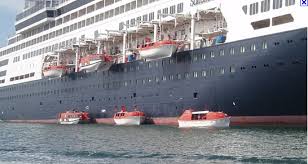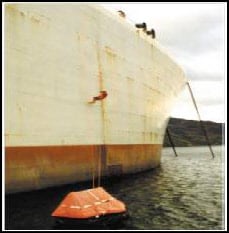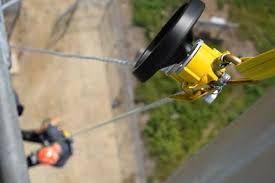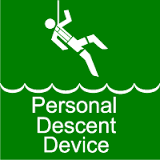It is a wonderful sea day out here today, sunny but not too warm as the wind is now more from the N.E than from the S.E and thus brings cooler Atlantic air towards the Bahamas. Still it is around 80oF /27oC. but it only feels like it when in the full sunshine. Thus our nearly 2100 charter people are having a grand final day. I wonder how long it will take to process all of them through Immigration tomorrow. Most of them are Americans so it might go fast. I will find out as I will have to go ashore again to be instrumental in helping to produce the “zero count”; meaning the ship is completely empty of everybody who is not considered a crew member.
The Nieuw Amsterdam is an evolution of the Vista Class and both the Signature and Vista Class differ from the other ships if you look at the outside. I do not mean looking at the superstructure or the number of lifeboats but at the lack of “blue covers” you see near the lifeboats on the S and R class. There, near each lifeboat station, is a blue cover which looks vaguely like a drum. Inside this blue cover is a rope ladder, called a Jacobs Ladder. It is used to offer those who are lowering lifeboats and life rafts a means of escape if they are not able to jump in the last boat or raft going down.
However those ladders are cumbersome to handle, need a lot of maintenance (rope and sea air do not go well together) and they take up a lot of space. Either by taking deck space away, if they are stored on the Lifeboat Embarkation Deck, or on dedicated platforms if stored next to the lifeboat. 4 or 5 of those platforms would make enough room for a complete lifeboat if they were not there. Thus the shipping industry adopted a different solution. A descent device.
Descending devices were not invented by the cruise industry. They originate from mountain climbing and were later adopted also in the building and construction industry. I believe there they are called a Friction or Rappel Device. In principle these devices are very simple. It is a rope with at each end a loop for somebody to hang on to and a controlled brake in the middle. It is hung on a small arm extending from the lifeboat deck over the water and when in the loop a person can just step over the side and glide down to the water with a controlled speed. The loop at the other end of the rope comes up to the deck and the next person can than descend until everybody has safely escaped.
The requirement for having Jacobs’s ladders disappeared somewhere around the year 2000 and as a result all the Vista class were fitted with them. I mention the year 2000 as it depends on the year in which the keel has been laid to what legal requirements a ship has to comply with. So it is possible that one ship in a class of 4 similar vessels has different Solas requirements to comply with than another ship. Our Prinsendam with a keel laid in 1987 falls under Solas 1974 with a number of Amendments. Our Koningsdam is built under the latest Solas regulations, which, if applied to the Prinsendam would mean that the whole Prinsendam would have to be rebuilt.
This does not mean that the Prinsendam is unsafe, far from it; it means that it uses other equipment to achieve the same result. Hence the Prinsendam has rope ladders and the Koningsdam will have Descent Devices. Rope ladders do the same thing as a descent device but instead of gravity doing the work for you, you have to climb down.
Tomorrow we are in Fort Lauderdale and according to the Broward Country Traffic Board (which lists all the coming and going ships) we can expect the Carnival Conquest, Navigator of the Seas, Allure of the Seas, Regal Princess, Eurodam, Celebrity silhouette and us. So it is going to be busy at the sea-buoy between 5 and 7 tomorrow morning. It is also going to be busy in town and Ft. Lauderdale has issued a warning for severe delays. There is a car race going on, women beach ball champion ships, a marathon and a number of other things which might result in a severe clogging of several roads. Then with 15000 cruise guests leaving and a similar number going to the ships things might get interesting. The Sheriff’s department of Broward County will not be bored. But at least they should have nice weather.
There is another – small- frontal system approaching which will bring rain on Monday over Florida and that means that tomorrow it will not be too warm. 70oF / 21oC, sunny and a moderate breeze.





February 14, 2016 at 9:46 pm
So Captain, do all the lifeboat crew members have to learn and regularly practice the use of the rappelling device?
February 15, 2016 at 4:36 pm
Thank you for reading my blog.
No only the crew who could be left behind (sailors and other crew members involved in operating the winches of the boats and rafts) need to know. All other crew will be accounted for and assigned a space in the liferafts before the last crew leaves the ship. The descent device is a back up device. In principle all crew should have a place in a lifeboat or liferaft before the last one goes down. The final raft/boat can be lowered by means of a pully which lifts the winch break remotely.
Thank you for asking
Best regards
Capt. Albert